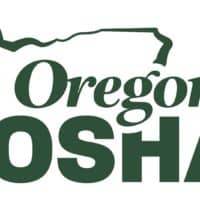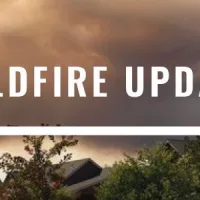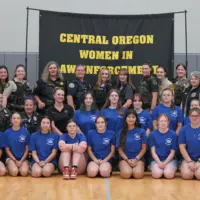
Moving to increase protections for workers against the effects of climate change, Oregon OSHA is adopting two new and distinct emergency rules. One puts protections in place against the hazards of wildfire smoke. Another establishes safeguards against high heat in employer-provided housing.
The wildfire smoke rule encompasses a variety of exposure controls, training and information, and other measures. The heat rule applies to occupants of housing provided by employers. It requires access to cooling areas and other steps to minimize dangerous heat in housing units.
Both rules take effect Aug. 9 and remain in effect for 180 days. The rules reflect those provisions Oregon OSHA believes can be put in place immediately and are based largely on input from labor and employer stakeholders.
“These rules underscore our ongoing work to bolster Oregon’s ability to protect workers from extraordinary hazards that have been exacerbated by climate change,” said Andrew Stolfi, director of the Oregon Department of Consumer and Business Services, which includes Oregon OSHA. “Wildfire smoke and extreme heat continue to pose threats to our communities. Those threats are not going away. And that is why we must act.”
“These latest measures reflect our long-standing mission of advancing protections for all Oregon workers,” said Michael Wood, administrator for Oregon OSHA. “That mission is even more important now in light of the unprecedented challenges to worker safety.”
“We believe these rules provide better safeguards for workers,” Wood added, “and create greater clarity for employers as they move forward.”
The two temporary rules follow Oregon OSHA’s July 8 adoption of emergency requirements to prevent heat illness in outdoor and indoor workplaces. In addition to its enforcement tools, Oregon OSHA offers employers free consultations and expert advice to help comply with the requirements. Meanwhile, the division continues to develop a permanent wildfire smoke rule with an eye toward adoption this fall. Also, it is working on permanent protections involving housing provided by employers.
Workers have a right to a safe and healthy workplace. That includes the right to raise concerns free from retaliation and to file a complaint with Oregon OSHA. Oregon OSHA encourages a careful reading of the temporary rule providing protection from wildfire smoke – which includes protective measures for employer-provided housing – and of the temporary rule addressing high heat in employer-provided housing. The following are summaries of each rule’s provisions:
Protection from wildfire smoke
The wildfire smoke rule applies to employers whose employees are – or will be – exposed to wildfire smoke where the ambient air concentration for fine particulate matter (also known as PM2.5) is at or above an Air Quality Index (AQI) 101, which is unhealthy for sensitive groups. Sensitive groups include people with lung and heart problems; children younger than 18 and adults older than 65; pregnant women; and people with diabetes.
Workplaces and operations that are exempt from the rule include enclosed buildings in which the air is filtered by a mechanical ventilation system and enclosed vehicles in which the air is filtered by a cabin air filter. In both cases, doors and windows must be closed, except when it is necessary to enter or leave.
Information and training
- Beginning Aug. 16, 2021, employers must ensure workers who may be exposed to AQI 101 have been trained in a manner and language they understand.
- Such training must include the following topics:
- The potential health effects of wildfire smoke, including increased risk of health effects to sensitive groups
- The symptoms of exposure, including burning sensations in the eyes; runny nose, sore throat, cough, and difficulty breathing; and fatigue, headache, and chest pain
- How employees can get the current and forecasted AQI level
- How to operate and interpret any air quality monitoring device provided by the employer
- The employer’s methods to protect workers from wildfire smoke
- Emergency response procedures
- The employee’s right to report health issues and obtain medical treatment without fear of retaliation
- Two-way communication system for wildfire smoke hazards
- The importance, limitations, and benefits of using filtering facepiece respirators when provided by the employer, and how to properly put them on
Communication system
- Before workers are exposed to an AQI 101, employers must develop and implement a system to communicate wildfire smoke hazards, including:
- Notifying employees when the worksite’s ambient air concentration is at or above AQI 101
- Giving notification when ambient air concentration is at or above an AQI 201, which involves very unhealthy air quality with the risk of health effects increased for everyone.
- Notifying employees when the ambient air concentration is at or above an AQI 500.
- Notifying employees when the ambient air concentration drops below levels requiring protective measures.
Exposure controls
- Whenever feasible, employers must use engineering or administrative controls to reduce employee exposure to less than AQI 201. Engineering controls include enclosed buildings or vehicles where the air can be adequately filtered. Administrative controls include relocating work to another outdoor location with better air quality or changing work schedules.
- Whenever employee exposure exceeds AQI 201, even after the use of engineering or administrative controls – or both – employers must ensure workers wear filtering facepiece respirators approved by the National Institute for Occupational Safety & Health (NIOSH). Such respirators include what is commonly known as an N95.
- Whenever employee exposure exceeds an AQI 101, employers must maintain an adequate supply of NIOSH-approved filtering facepiece respirators that effectively protect wearers. Such respirators must be provided at no cost and be readily available for voluntary use to all exposed workers at their request.
- For the 2021 season, KN95s previously approved under the U.S. Food and Drug Administration’s emergency use authorization can be substituted for NIOSH-approved filtering facepiece respirators for exposures below an AQI 499. For exposures at AQI 500 and above, NIOSH-approved filtering facepiece respirators must be used.
Meanwhile, Oregon OSHA is coordinating with several partners on the distribution of respirators. That coordination includes working with the Oregon Department of Agriculture, the Oregon Home Builders Association, the Associated General Contractors Oregon Columbia Chapter, and Hoffman Construction.
Employer-provided housing heat rule
- Cooling areas. If rooms where people sleep are not able to maintain an indoor temperature of 78 degrees Fahrenheit or less, then employers must provide an area for occupants to cool off whenever the heat index outside the housing is at or above 80 degrees Fahrenheit. The cooling areas – large enough to accommodate at least 50 percent of the occupants at any one time – can use a combination of these two approaches but employers are encouraged to provide at least some of the required space indoors:
- Giving occupants continual access to one or more common rooms maintain at or below 78 degrees Fahrenheit (using air conditioners, evaporative coolers, air purifiers with coolers, or other reliable means).
- Giving occupants continual access to outdoor rest areas, away from work areas or activities that could cause a hazard. Rest areas must be shaded; provide water misters, cooling vests, or equally effective means of relief; and provide adequate seating.
- Minimizing heat in housing units. If rooms where people sleep are not able to maintain an indoor temperature of 78 degrees Fahrenheit or less, employers must take steps, including:
- Maximizing the ability to keep housing cool by ensuring windows can be protected from direct sunlight during all hours of the day – through the use of artificial or natural shade – including coverings to deflect radiant heat from the sun
- Making fans available at no cost for any occupants who want to use them
- Temperature awareness. Employers must provide a thermometer that displays the temperature in both Fahrenheit and Celsius in each housing unit.
- In addition to training for employees and supervisors about the dangers of heat illness, employers must display the “Heat Risks in Housing” poster provided by Oregon OSHA so occupants can see it. The poster is available in both English and Spanish.
- Access to emergency services. Employers must ensure occupants have access to a working telephone to contact emergency services.
Consultation, technical advice, educational and other resources
Oregon OSHA offers free resources – involving no citations, no penalties, and no fault – to help employers comply with workplace health and safety requirements. They include:
Consultation services – Provides free help with safety and health programs, including how to control and eliminate hazards, and hands-on training
- Phone (toll-free in Oregon): 800-922-2689
- Field offices
- Online
- Email: consult.web@oregon.gov
Technical staff – Helps employers understand requirements and how to apply them to their worksites
- Phone (toll-free in Oregon): 800-922-2689
- Online
- Email: tech.web@oregon.gov
Also, the Oregon Department of Consumer and Business Services, which includes Oregon OSHA, maintains the Multicultural Communications Program that provides outreach to communities with limited English proficiency. That outreach encompasses information about on-the-job safety and health. The program includes a toll-free phone number for Spanish-speaking Oregonians: 800-843-8086.
Oregon OSHA encourages workers to learn about their rights to raise safety concerns and to protect against retaliation.
The division offers a how-to video on the proper care and use of N95 respirators in Spanish and English. Other resources include:
- Oregon Smoke Information blog
- Oregon OSHA heat illness prevention A-to-Z topic page
- Oregon Department of Environmental Quality (DEQ) wildfire response
- Oregon Health Authority (OHA) wildfires and smoke
Oregon OSHA, a division of the Department of Consumer and Business Services, enforces the state’s workplace safety and health rules and works to improve workplace safety and health for all Oregon workers. For more information, visit Oregon OSHA.















